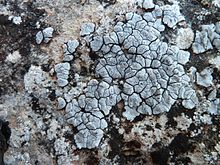| Placocarpus schaereri | |
|---|---|

| |
| Scientific classification | |
| Domain: | Eukaryota |
| Kingdom: | Fungi |
| Division: | Ascomycota |
| Class: | Eurotiomycetes |
| Order: | Verrucariales |
| Family: | Verrucariaceae |
| Genus: | Placocarpus |
| Species: | P. schaereri |
| Binomial name | |
| Placocarpus schaereri (Fr.) Breuss (1985) | |
| Synonyms | |
Placocarpus schaereri is a species of saxicolous (rock-dwelling), areolate, and crustose lichen in the family Verrucariaceae. Found in Europe, it is the type species of genus Placocarpus. The lichen was first described scientifically in 1831 by Elias Magnus Fries, who called it Parmelia schaereri. The species epithet honours Swiss pastor and lichenologist Ludwig Schaerer. Othmar Breuss transferred it to the newly reinstated genus Placocarpus in 1985.
Juvenile forms of Placocarpus schaereri are often parasitic on the lichen Protoparmeliopsis muralis.
References
- "Synonymy: Placocarpus schaereri (Fr.) Breuss, Pl. Syst. Evol. 148(3-4): 314 (1985)". Species Fungorum. Retrieved 10 May 2022.
- Fries, E.M. (1831). Lichenographia Europaea Reformata (in Latin). Lundin. p. 106.
- Breuss, O. (1985). "On the Lichen genera Placocarpus and Placidiopsis (Verrucariaceae)". Plant Systematics and Evolution. 148 (3–4): 313–315. doi:10.1007/BF00985931.
- Diederich, Paul; Lawrey, James D.; Ertz, Damien (2018). "The 2018 classification and checklist of lichenicolous fungi, with 2000 non-lichenized, obligately lichenicolous taxa". The Bryologist. 121 (3): 340–425 . doi:10.1639/0007-2745-121.3.340. S2CID 92396850.
| Taxon identifiers | |
|---|---|
| Placocarpus schaereri | |
| Parmelia schaereri | |